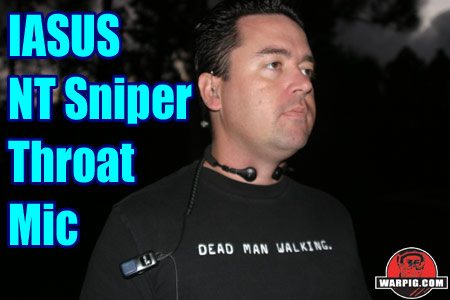  |
|
|
|
|
|
|
  |
|
|
|
|
|
|

Sample for review
provided by:
To listen to an
MP3 soundcheck of the Sniper B, CLICK
HERE (2.3MB)
What
do you think?
|

Noise Terminator - Sniper B By Bill Mills - Jan 2005 Photos by Dawn Mills Radios may be forbidden on tournament paintball fields, but for wooded recreational play, and especially scenario games, good communication can give any team a tactical edge. In the 1990s when the Federal Communications Commission opened up the Family Radio Service (FRS) radio band, they paved the way for a variety of low cost, license free two-way radios with usable ranges of over a mile.
While some paintball players will be happy using a standard walkie-talkie type arrangement on the field, others donít want the squawk of a radio to give them away, or to have to hold their radio up to their face to speak (most paintballers will realize that bushes donít use radios, and quickly recognize a player in a ghillie suit who is holding a radio to his face.) Thus, the use of headsets with radios can be advantageous. Headsets typically combine an earpiece with a compact microphone on a small boom, or molded into the earpiece cable. Quality of the sound transmitted through these microphones depends on keeping the mic near the mouth, and sheltered from background and breathing noises.
The Noise Terminator Sniper B is a dual pick up throat mic. Its spring metal band wraps around the wearers neck from the back, and disk shaped pick ups on each end sit on the sides of the Adamís Apple. The sniper Bís ear piece uses an acoustic coil setup. Its tiny speaker is actually on the back of the neck piece, but a thin clear coiled tube carries the sound to a soft silicone earpiece, in an arrangement that looks reminiscent of a television news anchor or Secret Service agent earpiece.
The Sniper B does not support VOX, or voice activation of the radio with which it is used. Rather, it has a push to talk (PTT) button molded into its cable. The PTT button also features a clip on its back, and a volume control for the earpiece in its side. This arrangement allows the user to place their radio in a pack, combat vest pocket, or anywhere else secure, and still have control of the volume, and the ability to activate the radio to transmit. The coiled cord from the throat mic to the PTT button is approximately 3 feet long when stretched, and the remaining length to the radio jack stretches out to about six feet.
The lightweight acoustic earpiece didnít fall out through a variety of movements, and offered clear, crisp sound. Iasus also manufactures a lower cost single-pickup throat mic, and one of the features they cite when comparing the Sniper is better stability of the coiled acoustic earpiece setup. Similarly the dual pickup throat mic, provided a clean sound, regardless of surrounding noises. Because of the way throat mics pick up sound, they donít do as well with the noises made at the front of the mouth, such as Ss and the difference between a D and B, so it can take a little getting used to using them. Background noise was completely not an issue with the Sniper B, and that is something which is key to effective communication when surrounded by firing paintguns or paintball tanks blaring loud music.
You can listen to a radiocheck comparing the Iasus Noise Terminator Sniper B to an acoustic microphone, as well as showing the effects of proper mic placement by downloading this MP3 file (2.3MB download). Iasus throat microphones are presently available through a limited number of authorized retailers in the United States, UK and Australia. Its suggested retail price of $115 is higher than the cost of the radios most paintball players would use it with, but its features and effectiveness place it in a level above throat mic models priced in the $50 range. |
| Copyright © 1992-2019
Corinthian Media Services. WARPIG's webmasters can be reached through our feedback form. All articles and images are copyrighted and may not be redistributed without the written permission of their original creators and Corinthian Media Services. The WARPIG paintball page is a collection of information and pointers to sources from around the internet and other locations. As such, Corinthian Media Services makes no claims to the trustworthiness or reliability of said information. The information contained in, and referenced by WARPIG, should not be used as a substitute for safety information from trained professionals in the paintball industry. |